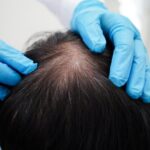Hair loss can be challenging for many women, affecting confidence and self-esteem. While treatments like hair transplants are popular, scalp reduction surgery is another option that some may consider. Scalp reduction involves surgically removing bald areas of the scalp and stretching the hair-bearing portions to cover the gaps. Here are 15 key things South African women should know about scalp reduction:
1. What is Scalp Reduction?
Scalp reduction surgery is a procedure where sections of bald scalp are surgically removed, and the surrounding hair-bearing scalp is stretched and repositioned to cover the area. It’s often used to treat extensive baldness at the crown of the head.
2. Who is a Good Candidate?
Women experiencing significant hair loss on the crown or top of the scalp due to conditions like androgenetic alopecia may be good candidates for scalp reduction. However, it’s best suited for women with flexible scalps and stable hair loss patterns.
3. How the Procedure Works
During the surgery, the surgeon will remove a portion of the bald scalp, usually in an elliptical or U-shape. The hair-bearing areas on either side of the scalp are then pulled together and sutured to cover the area where baldness was removed.
4. When Scalp Reduction is Most Effective
Scalp reduction is most effective for people with localized bald spots, typically at the crown or vertex of the scalp. It’s less suitable for those with diffuse thinning across the entire scalp, as it only addresses specific areas of hair loss.
5. Combination with Hair Transplants
Scalp reduction can be combined with other treatments like hair transplants. For example, after reducing a large bald area, hair transplants can be used to fill in any remaining thinning patches, resulting in fuller coverage.
6. Potential Benefits
One key advantage of scalp reduction is that it can immediately reduce the size of the bald area, unlike treatments that require months for hair growth. For women struggling with large bald spots, this can offer quick and noticeable improvements.
7. Risks and Complications
Like any surgical procedure, scalp reduction carries risks. These include infection, excessive scarring, and the possibility of an unnatural hairline or visible tension on the scalp. In rare cases, the scalp may not stretch enough to close the gap effectively, leading to complications.
8. Healing and Recovery
The recovery period for scalp reduction can vary, but it typically takes about two weeks for the initial healing. During this time, patients may experience swelling, tenderness, and tightness in the scalp, which usually subsides as the area heals.
9. Cost in South Africa
The cost of scalp reduction surgery in South Africa can range from R40,000 to R120,000, depending on the extent of the procedure and the clinic. Because it is a surgical procedure, it’s essential to consult with a highly qualified plastic surgeon or hair restoration specialist.
10. Scarring
Scalp reduction can result in noticeable scarring, especially if large areas are removed. However, experienced surgeons will attempt to place the scars where they can be hidden by surrounding hair. It’s important to discuss scar placement during your consultation.
11. Long-Term Results
The results of scalp reduction are permanent, but it’s important to note that hair loss in other areas may continue over time. Additional procedures, such as hair transplants or further scalp reductions, may be required if hair loss progresses.
12. Potential for Tightness in the Scalp
Some women may experience tightness in the scalp after surgery, especially when large areas of skin have been removed. This can lead to discomfort or even limit the scalp’s flexibility for future hair restoration treatments.
13. Post-Surgical Hair Loss
In some cases, patients may experience temporary shock loss—hair loss around the surgical area after the procedure. While this is often temporary, it can take several months for the hair to grow back fully.
14. Scalp Reduction for Traction Alopecia
Scalp reduction can be an option for women suffering from traction alopecia—hair loss caused by excessive tension from hairstyles like tight braids or ponytails. By removing the damaged scalp areas, healthy hair-bearing regions can be repositioned.
15. Consultation is Crucial
Before undergoing scalp reduction surgery, a thorough consultation with a hair restoration specialist is essential. They will assess the pattern and extent of your hair loss, your scalp elasticity, and other factors to determine if scalp reduction is the right choice for you.
For South African women experiencing significant hair loss, scalp reduction surgery can offer a quick solution by removing bald areas and stretching hair-bearing skin to cover them. However, it’s important to carefully weigh the potential benefits against the risks, such as scarring and post-surgical tightness. Consulting with a specialist will help you determine if this procedure aligns with your hair restoration goals and if it can be combined with other treatments like hair transplants for optimal results.








